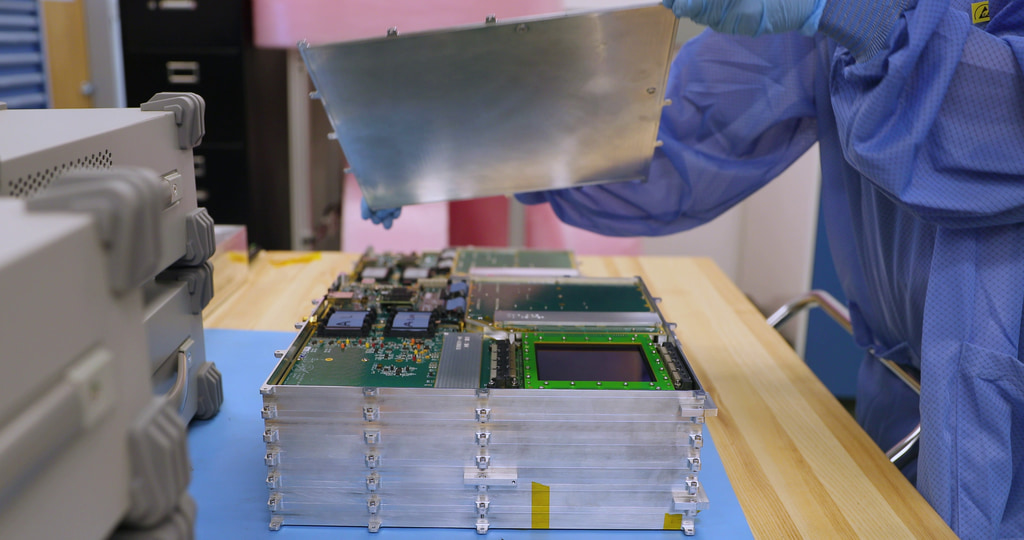ComPair Thermal Vacuum Photos

Team members work on the ComPair balloon instrument before it begins testing in a thermal vacuum chamber at NASA’s Goddard Space Flight Center in Greenbelt, Maryland. ComPair project manager Regina Caputo (front right), graduate student Nicholas Kirschner (George Washington University, left), and research scientist Nicholas Cannady (University of Maryland Baltimore County, rear) examine ComPair's various components to determine what needs to be “harnessed,” or connected via cable to power systems and the onboard computer.
Credit: NASA/Scott Wiessinger
Engineers and scientists assembled and tested NASA’s ComPair (short for Compton Pair) balloon instrument in preparation for its scheduled flight in August 2023 during NASA’s fall balloon campaign at Fort Sumner, New Mexico. ComPair’s goal is to test new technologies for studying gamma rays, the highest-energy form of light. The images here were collected in June 2023.
ComPair is designed to detect gamma rays with energies between 200,000 and 20 million electron volts. (For comparison, the energy of visible light is 2 to 3 electron volts.) Supernovae and gamma-ray bursts, the most powerful explosions in the cosmos, glow brightest in this range, as do the most massive and distant active galaxies, which are powered by supermassive black holes. Scientists know this because they see a fraction of the light emitted by these galaxies with NASA’s Fermi Gamma-ray Space Telescope, which observes higher-energy gamma rays.
The mission team assembled all the components and tested them in a large thermal vacuum chamber at NASA’s Goddard Space Flight Center in Greenbelt, Maryland, to assess how they function at balloon altitudes. The next step is to fly the instrument. The August flight will carry ComPair to about 133,000 feet (40,000 meters), or nearly four times the cruising altitude of a commercial airliner.
ComPair is a collaboration among Goddard, the Naval Research Laboratory in Washington, Brookhaven National Laboratory in Upton, New York, and Los Alamos National Laboratory in New Mexico.

Kirschner (left), Caputo (right), and Cannady (rear) continue to harness ComPair's four main components: tracker, high-resolution low-energy calorimeter, high-energy calorimeter, and anticoincidence detector.
Credit: NASA/Scott Wiessinger

From left to right, Cannady, ComPair principal investigator Carolyn Kierans, and Janeth Valverde Quispe (University of Maryland Baltimore County) assess ComPair ahead of testing in a thermal vacuum chamber.
Credit: NASA/Scott Wiessinger

ComPair team members prepare the instrument for thermal vacuum testing. Once closed, the chamber will begin to simulate conditions the mission will experience during its balloon flight, which will take it to about 133,000 feet (40,000 meters), or nearly four times the cruising altitude of a commercial airliner.
Credit: NASA/Scott Wiessinger

Kierans (left), Valverde Quispe (right), and Cannady (rear) continue harnessing work on ComPair ahead of thermal vacuum testing.
Credit: NASA/Scott Wiessinger

Kierans (left), Valverde Quispe (right), and Cannady (rear) continue harnessing work on ComPair ahead of thermal vacuum testing.
Credit: NASA/Scott Wiessinger

Kierans (left), Valverde Quispe (right), and Cannady (rear) continue harnessing work on ComPair ahead of thermal vacuum testing.
Credit: NASA/Scott Wiessinger

A member of the ComPair team places a hand atop the instrument. ComPair contains four main components: the tracker, a high-resolution low-energy calorimeter, a high-energy calorimeter, and an anticoincidence detector. The tracker and calorimeters are stacked on top of each other and study gamma rays. The anticoincidence detector detects the entry of high-energy charged particles called cosmic rays, allowing ComPair’s other detectors to ignore them.
Credit: NASA/Scott Wiessinger

In addition to the four science components, ComPair has an onboard computer and several power systems. The resulting coils of cables connecting all the parts require careful management.
Credit: NASA/Scott Wiessinger

The ComPair mission rolled into the chamber ahead of thermal vacuum testing.
Credit: NASA/Scott Wiessinger

After shutting ComPair into the chamber, scientists and engineers monitored the instrument as the internal environment began to simulate what the mission will experience at balloon altitudes.
Credit: NASA/Scott Wiessinger
This video shows the ComPair team preparing the instrument for thermal vacuum testing. The first nine shots show Kirschner, Cannady, and Caputo harnessing the components. Shots 10, 11, and 12 show Kierans, Cannady, and Valverde Quispe also working on harnessing. On shots 13 to 17, Kierans and Cannady install the final wall and top of the anticoincidence detector. Kierans inspects the now foam-board-covered instrument before it’s wheeled into the chamber in shot 18. In shots 19 and 20, Goddard’s Jancilon Viegas and Geovanni Munguia, with help from Lucas Smith (University of Maryland, College Park), wheel ComPair into the chamber. In shot 21, Munguia connects temperature sensors before the door to the chamber is closed. Goddard’s Christopher Mazza installs the power feedthrough for the chamber in shots 22 and 23. Munguia, Mazza, and Goddard’s Philip Mitchell remove the platform to the mouth of the chamber and shut the door in shots 24 and 25. In shot 26, Kierans gives instructions to the ComPair team as they prepare to run tests while the instrument is in the chamber. From left to right: Kierans, Thomas Caligiure (Naval Research Laboratory), Sambid Wasti (Catholic University of America), Caputo, Valverde Quispe, Makoto Sasaki (University of Maryland, College Park), Smith. Shot 27 shows the same team meeting, from the opposite side.
Credit: NASA/Scott Wiessinger
Credits
Please give credit for this item to:
NASA's Goddard Space Flight Center
-
Producer
- Scott Wiessinger (KBR Wyle Services, LLC)
-
Photographer
- Scott Wiessinger (KBR Wyle Services, LLC)
-
Science writer
- Jeanette Kazmierczak (University of Maryland College Park)
Release date
This page was originally published on Thursday, July 20, 2023.
This page was last updated on Tuesday, July 25, 2023 at 8:44 AM EDT.


